Physical Address
304 North Cardinal St.
Dorchester Center, MA 02124
Physical Address
304 North Cardinal St.
Dorchester Center, MA 02124
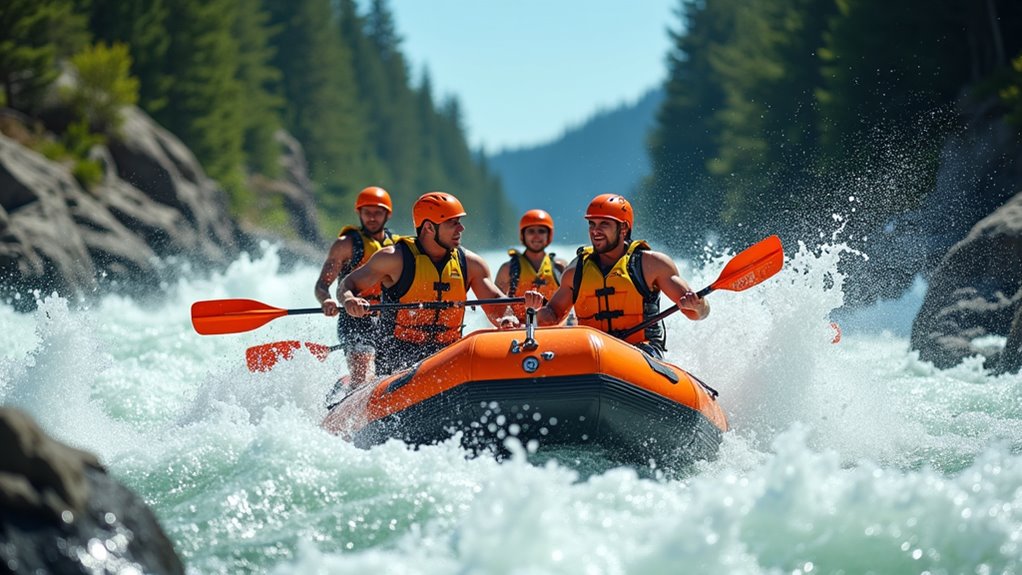
Navigate thrilling rapids and discover essential safety tips before booking your first white water rafting adventure.
You’re craving something beyond your usual weekend routine, and white water rafting might be exactly what you need. Before you book that first trip, though, you’ll want to understand what separates a relaxing Class I float from heart-pounding Class V rapids that demand serious skill and preparation. The difference between an amazing adventure and a dangerous situation often comes down to choosing the right river for your experience level and knowing what gear you absolutely can’t do without.
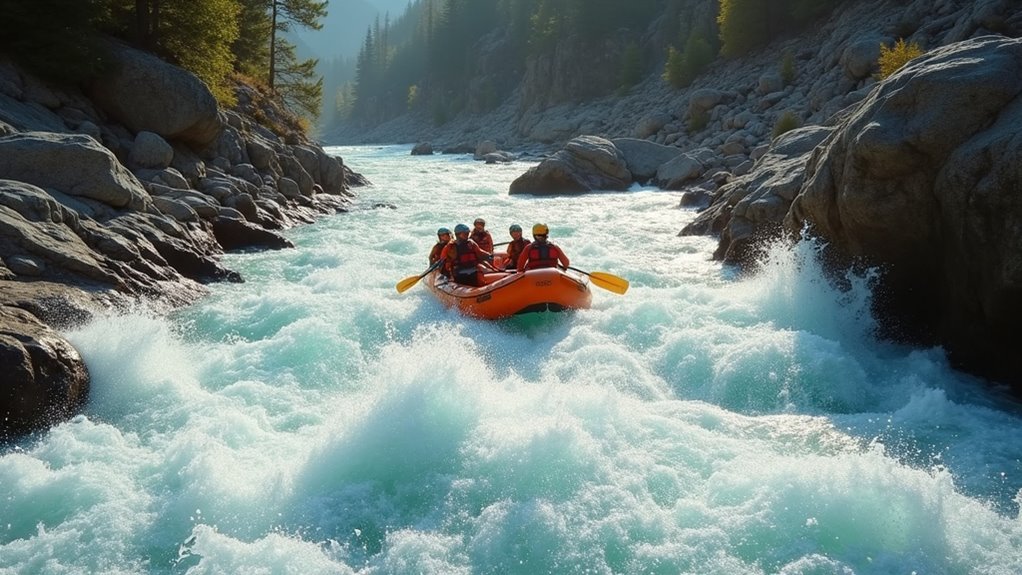
Before you book your first white water rafting adventure, you’ll need to understand the International Scale of River Difficulty that guides every rapids classification. This system ranks rapids from Class I through Class VI, with each level indicating specific challenges you’ll face on the water.
Class I rapids feature moving water with few obstacles—perfect for beginners.
Class II offers straightforward rapids with wide channels and occasional maneuvering.
Class III demands precise boat handling through irregular waves and strong currents.
Class IV presents intense, unpredictable rapids requiring expert skills.
Class V rapids offer extremely violent conditions with complex routes, while Class VI represents nearly impossible runs with extreme consequences.
Choose your difficulty level based on your swimming ability, physical fitness, and comfort with risk-taking situations. Most beginner rafting trips focus on Class I and II rapids to ensure a safe and enjoyable introduction to the sport.
Once you’ve selected your rapids classification, you’ll need proper gear to guarantee both safety and enjoyment on the water. Your helmet protects against rocks and unexpected impacts, while a properly fitted personal flotation device keeps you buoyant in turbulent currents.
Quick-dry clothing prevents hypothermia – avoid cotton materials that retain moisture and choose synthetic fabrics or neoprene wetsuits instead.
Secure footwear with ankle support prevents injuries on slippery rocks during launches and portages. You’ll want water shoes or old sneakers that won’t slip off in rapids.
Pack essentials in waterproof dry bags: sunscreen, snacks, first aid supplies, and spare clothing.
Many outfitters provide paddles, but experienced rafters often bring personal gear for better comfort and performance on challenging runs.
For multi-day adventures, consider bringing camping gear that can withstand outdoor conditions and provide comfortable rest between your white water sessions.
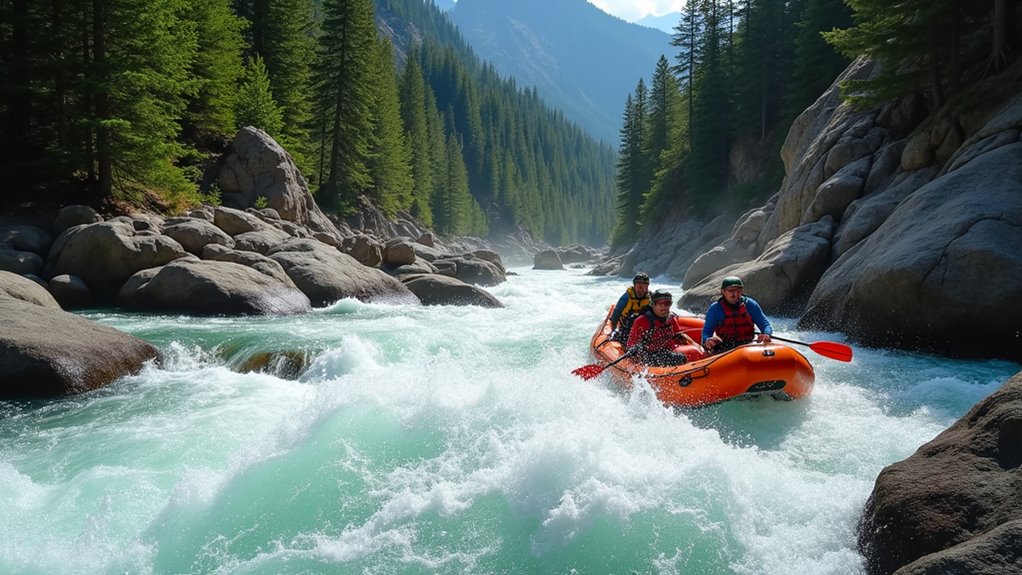
While proper equipment sets you up for success, selecting a destination that matches your abilities determines whether you’ll have an epic adventure or a terrifying ordeal. Beginners should target Class I-II rapids with gentle currents and minimal obstacles. These runs offer excitement without overwhelming technical challenges.
Choosing rapids that match your skill level transforms white water rafting from a nightmare into an unforgettable adventure.
Intermediate rafters can tackle Class III rapids featuring irregular waves, strong currents, and rocks requiring precise maneuvering. You’ll need solid paddling skills and quick decision-making abilities.
Advanced adventurers thrive on Class IV-V rapids with violent currents, complex routes, and significant consequences for mistakes. Only attempt these after mastering lower classifications.
Research specific rivers thoroughly. Consider water levels, seasonal conditions, and guide requirements. Local outfitters provide valuable insights about current conditions and difficulty variations throughout the year.
For those seeking even more extreme adventures beyond rafting, consider exploring glacier climbing trails that offer technical challenges in icy mountain environments.
Professional guides serve as your lifeline on challenging rivers, bringing years of experience and split-second decision-making skills that can mean the difference between an exhilarating ride and a dangerous situation. You’ll want guides certified by recognized organizations like the American Canoe Association or International Rafting Federation. They should demonstrate current wilderness first aid and CPR certifications.
Before launching, your guide must conduct thorough safety briefings covering paddle commands, proper positioning, and emergency procedures. They’ll inspect all equipment—helmets, life jackets, and rafts—ensuring everything meets safety standards.
Quality outfitters maintain strict guide-to-participant ratios, typically one guide per six rafters on technical runs.
Don’t hesitate to ask about your guide’s experience level on your specific river section. Their local knowledge of hazards, weather patterns, and rescue techniques directly impacts your safety.
Since multi-day rafting trips often involve overnight camping, consider bringing quality sleeping bags designed for outdoor adventures to ensure comfortable rest between challenging river runs.
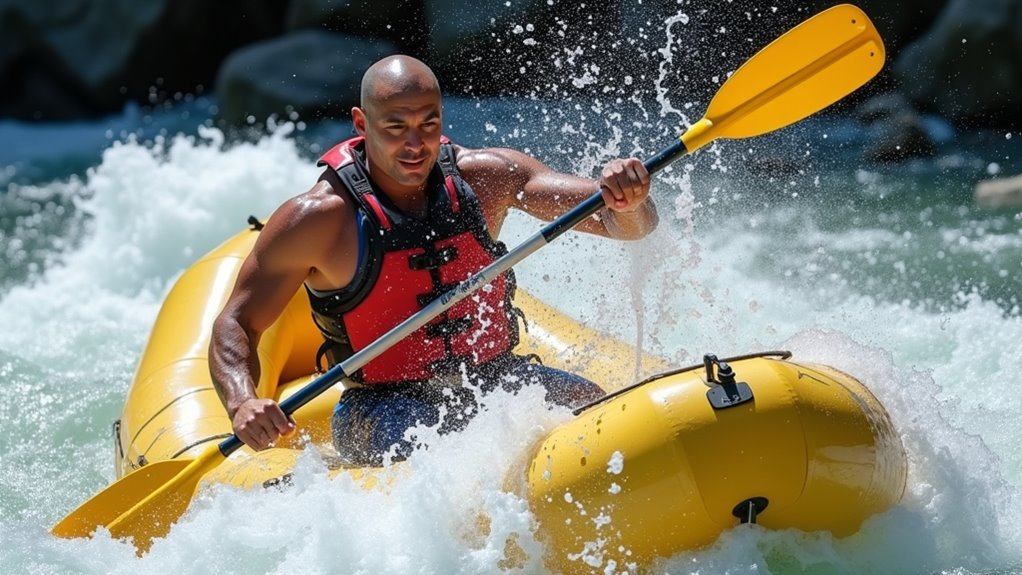
Although white water rafting doesn’t require Olympic-level fitness, you’ll need adequate cardiovascular endurance and upper body strength to paddle effectively through rapids and maintain control when the river fights back.
Start preparing weeks before your trip with regular cardio exercises like swimming, cycling, or brisk walking. Focus on building core strength through planks and rotational movements that mimic paddling motions.
Begin your white water preparation weeks ahead with swimming, cycling, and core-strengthening exercises that mirror actual paddling movements.
Practice holding paddles overhead for extended periods to condition your shoulders and arms. If you’re tackling Class III or higher rapids, incorporate pull-ups and rowing exercises into your routine.
Don’t neglect flexibility—tight muscles fatigue quickly on the water. Simple stretches targeting your back, shoulders, and wrists will pay dividends during those challenging multi-hour excursions downstream.
Consider exploring Britain’s Motorhome Show to discover mobile accommodation options that can serve as your base camp near prime rafting locations.
When spring snowmelt feeds rivers with powerful currents, you’ll find some of the most exhilarating rafting conditions of the year—but timing matters more than you might think. Peak season typically runs from April through September, when water levels remain consistent and temperatures stay comfortable.
You’ll encounter higher water volumes during late spring and early summer, creating Class IV and V rapids that challenge experienced rafters. Mid-summer offers moderate flows perfect for families and beginners. Fall provides crisp weather with lower water levels.
Weather profoundly impacts your experience. Avoid rafting during thunderstorms, as lightning poses serious risks on open water. Cold, rainy conditions require proper gear and can make hypothermia dangerous. Check local weather forecasts and river conditions before booking your trip.
If you’re planning multiple rafting adventures throughout the season, consider whether renting or buying watercraft makes more financial sense for your outdoor activities.

Since successful rafting depends entirely on your crew working as one unit, understanding group dynamics becomes essential before you push off from shore. You’ll need to establish clear communication signals with your team before hitting the rapids. Designate paddle commands like “forward,” “back,” and “stop” that everyone understands instantly.
Strong paddlers should position themselves in the bow and stern, while less experienced rafters work best in the middle seats. You’ll discover that timing matters more than individual strength – synchronized paddle strokes generate maximum power and control.
Trust builds quickly when you’re steering through challenging waters together. Listen to your guide’s instructions, support struggling teammates, and stay calm during intense moments. Remember, panic spreads fast in tight spaces, but so does confidence when everyone commits to working together.
Many rafting groups extend their adventures by staying at scenic RV parks that offer the perfect blend of outdoor excitement and comfortable accommodations near popular river destinations.
Beyond the thrill of conquering rapids as a team, you’ll want to preserve these unforgettable moments through photography. Invest in a quality waterproof camera case or action camera with secure mounting straps.
You’ll need both hands for paddling, so attach your camera to your helmet or life vest for quick access during calmer stretches.
Shoot in burst mode to capture split-second action shots of waves crashing over your raft. Focus on your teammates’ expressions – their excitement and determination tell your story best.
Natural light works perfectly, but avoid shooting directly into sunlight reflecting off water.
Time your shots between rapids when water’s calmer and you’re not actively paddling.
Consider bringing a backup memory card since you’ll take more photos than expected. If you’re on a budget, look for cheap camping gear options that include basic waterproof pouches as an alternative to expensive camera cases.
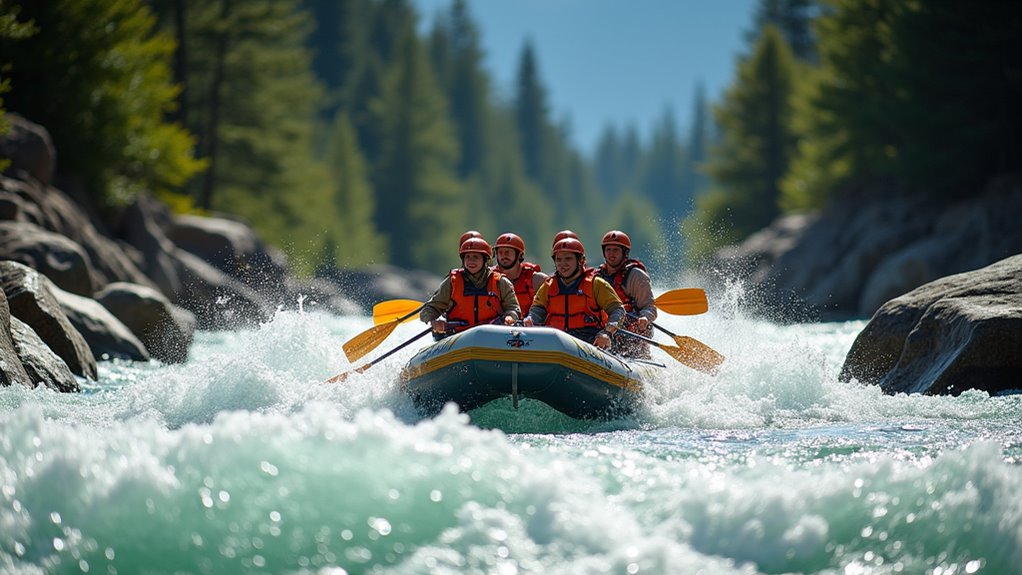
After you’ve experienced the rush of your first white water adventure, you’ll likely find yourself craving more challenging rapids and scenic rivers. Start planning by researching destinations that match your skill level—don’t jump from Class II to Class V overnight.
The addiction is real—once you’ve tasted white water adrenaline, you’ll be plotting your next river conquest before you’ve even dried off.
Consider seasonal factors like water levels, weather conditions, and peak tourist times when booking.
Book accommodations early, especially for popular rivers during prime season. Compare outfitters by reading reviews, checking safety records, and examining what’s included in packages. Some offer multi-day expeditions with camping, while others focus on day trips.
Create a gear checklist and determine what you’ll rent versus purchase. Budget for transportation, meals, tips, and potential equipment upgrades.
Most importantly, maintain your fitness level between trips—white water rafting demands physical endurance and strength.
If you’re planning a multi-day rafting expedition with overnight stays, apply the same camping trip planning principles to ensure you have proper shelter, food, and safety equipment for your riverside adventures.
Ready to plunge into your next adrenaline rush? You’ve got all the tools you need to plan an epic white water rafting adventure. From understanding rapid classifications to packing essential gear, you’re prepared to tackle those churning waters safely. Remember to match your chosen river to your skill level, follow your guide’s instructions, and don’t forget that waterproof camera. Your perfect rafting experience is just one booking away.